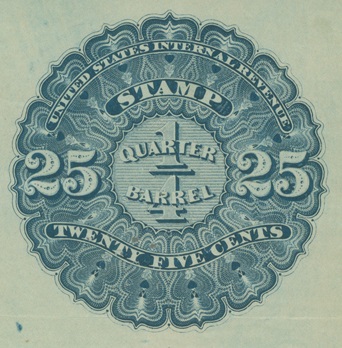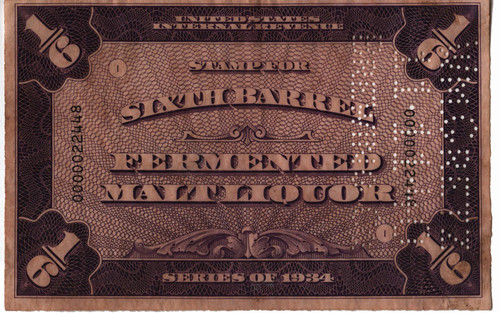
# REA197a - 1947 100 bbl. Beer Tax Stamp - carmine, cutout center
Beer Stamps
While duties, tariffs, and state taxes on beer had been instituted decades earlier, the first large-scale federal tax on beer was created on September 1, 1862. The tax was created to help fund the Union Army for the Civil War. During those four years, officials would collect the $1 per barrel tax in cash.
When the war came to an end, the government decided to keep the tax but also decided to start producing stamps to help account for paid taxes. The tax of $1 per barrel remained the same. The new stamps were produced for various barrel sizes between 1/8th of a barrel up to 1 hogshead. A hogshead was a 63-gallon container, equal to two 31.5 gallon barrels. These first stamps were issued on September 1, 1866, making them the first stamps issued for use on alcoholic beverages, though they didn’t appear in Scott Catalogue until 1994.
Brewers received Beer Tax Revenue stamps in imperforate sheets and were required to attach the stamps to the spigot of the beer barrel before it left the brewery. In most cases, this meant the stamps were destroyed when the barrels were opened. However, some people carefully removed the stamps and preserved them.
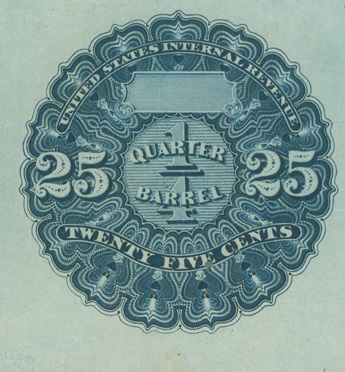
The first two issues of Beer stamps (1866 and 1867) had ornate circular designs. The stamps of 1870 had a square format with an open rectangular area in the center for the cancellation. Each stamp had different colored security lines in the cancellation area.
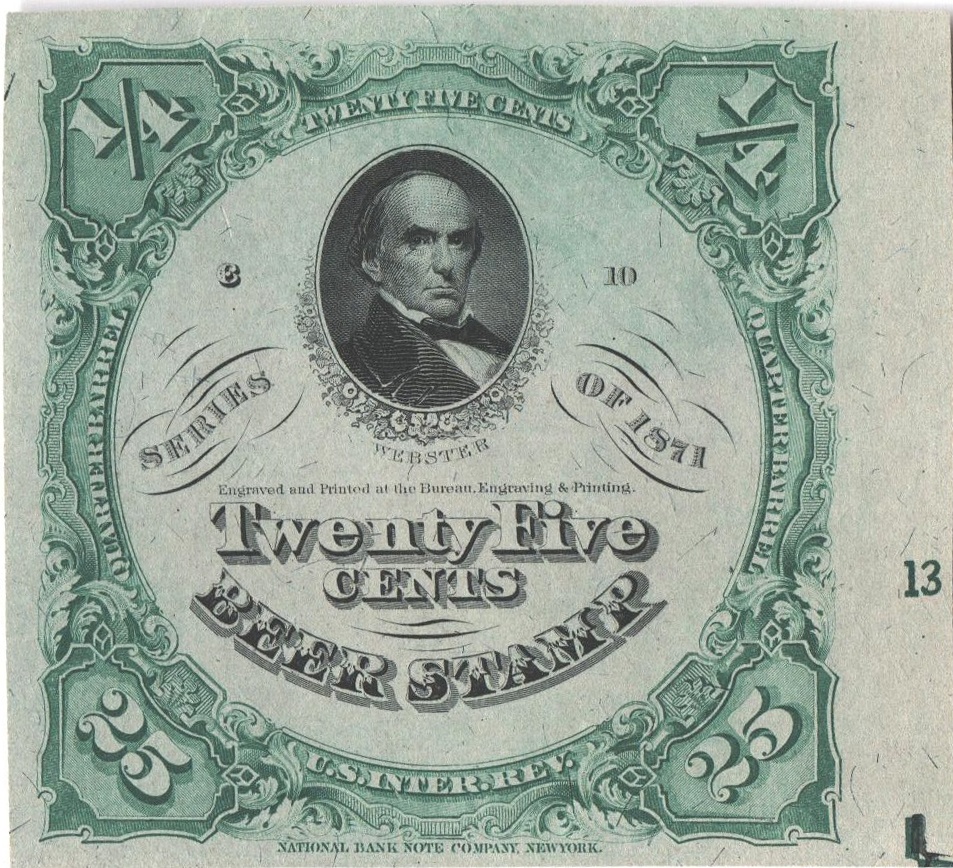
Up until 1870, each set of beer stamps was produced in six different denominations. In 1871, a new series was produced featuring seven denominations. The new set included a 33 1/3¢ for 1/3 of a barrel. These new stamps had a very different design too, they pictured historical figures – Andrew Jackson, Abraham Lincoln, Daniel Webster, David Farragut, William T. Sherman, Hugh McCulloch, and Alexander Hamilton. They also featured intricate scrollwork similar to that found on paper money and other security printing.

In 1875, another new series of Beer stamps was produced. Once again it included seven denominations, but this time they all had the same central vignette, which was called “Bacchus Serving the First Fermenter Brew to Man.”

A new series in 1878 returned to featuring portraits of notable Americans, though this set featured a different group – George Washington, Thomas Corwin, Thomas Hart Benton, George Thomas, Thomas Jefferson, Andrew Johnson, and Silas Wright.
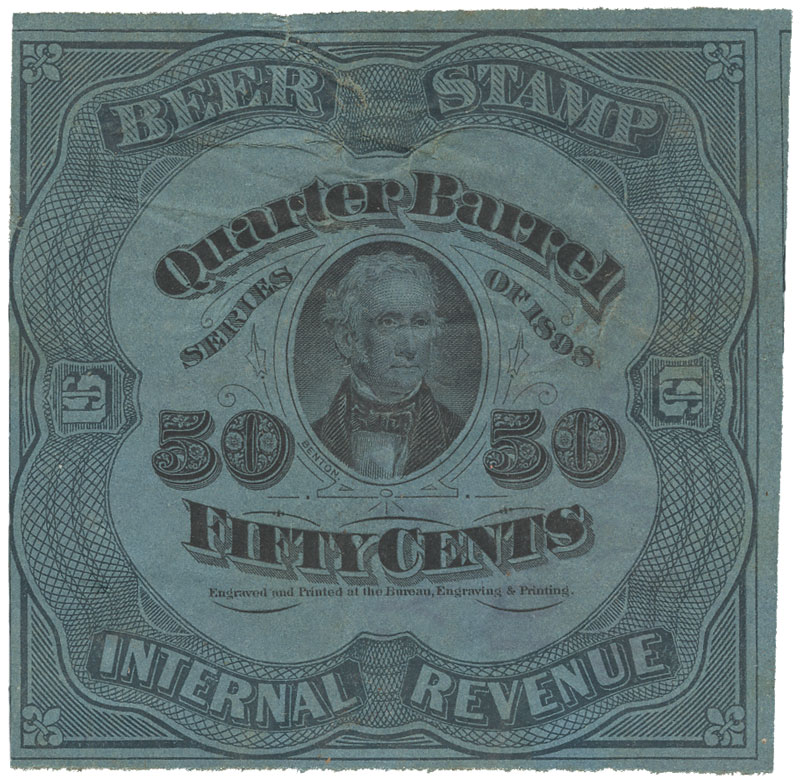
Twenty years later, the stamps of 1878 were surcharged to reflect an increase in the tax rate to $2 per barrel. The increase was put in place to help fund the Spanish-American War. Later in 1898, the stamps were reprinted with the new increased values.
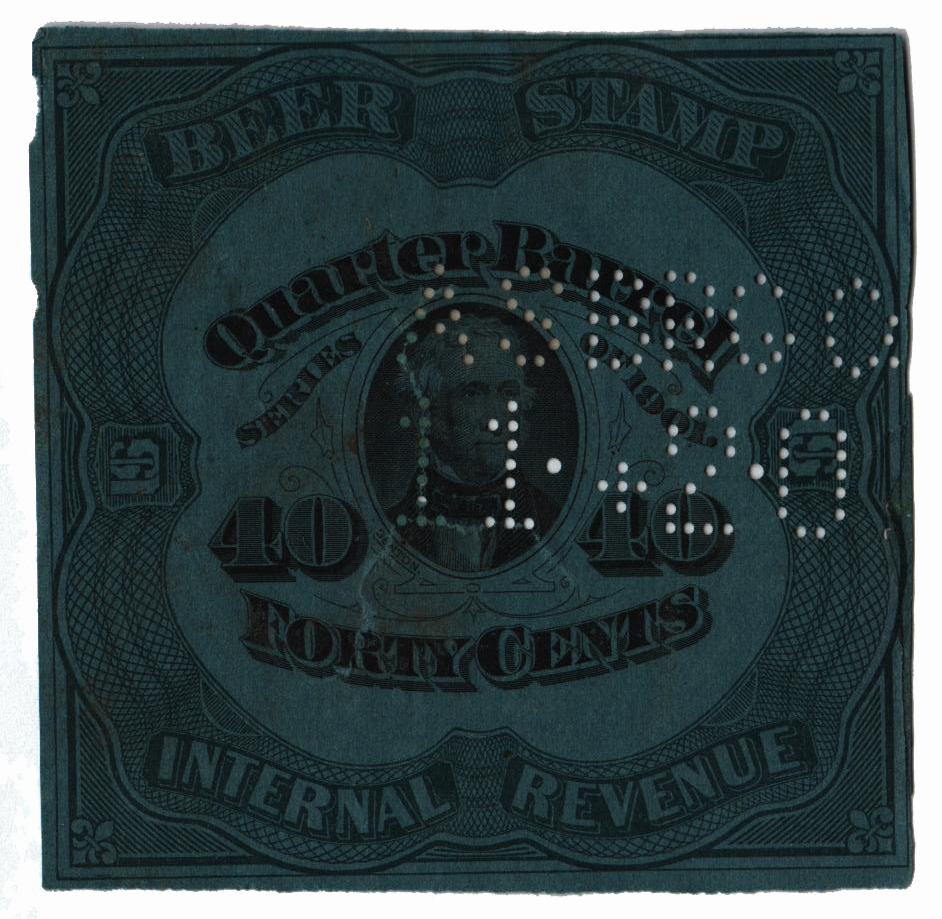
In 1901, the federal beer tax was reduced to $1.60 per barrel and new stamps featuring the same portraits from the previous issue were produced. Then in 1902, the tax rate was reduced to $1, so some stamps were surcharged and then all the stamps were again reissued at the new rate.
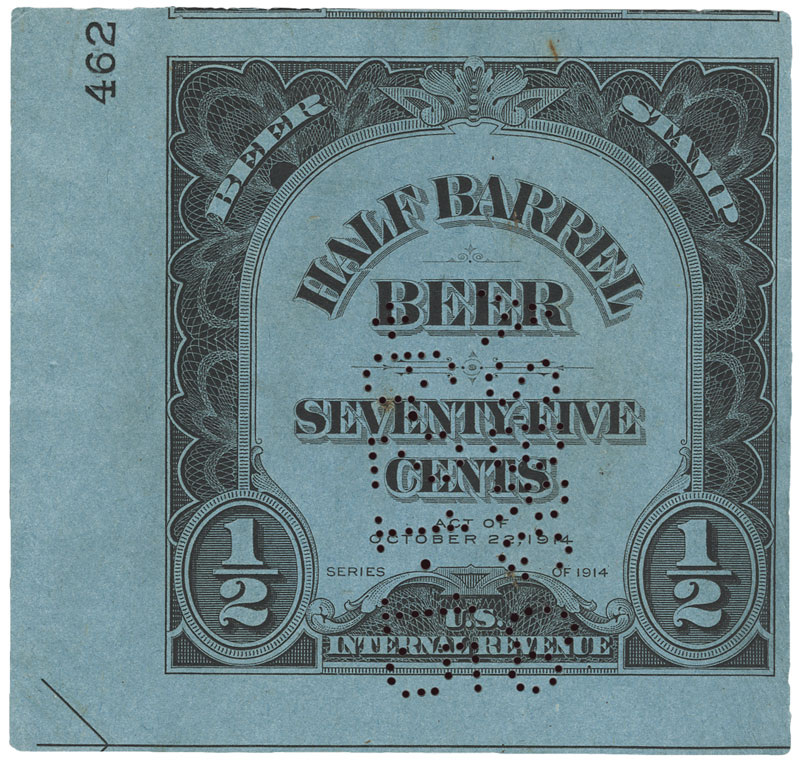
In 1909, the design with the historical figures was abandoned and new stamps were issued with large denominations in the center. In 1914, these stamps were surcharged to a new rate of $1.50 per barrel and overprinted “Emergency Tax Under Act of 1914.” New stamps were produced later that year to reflect the new rate.
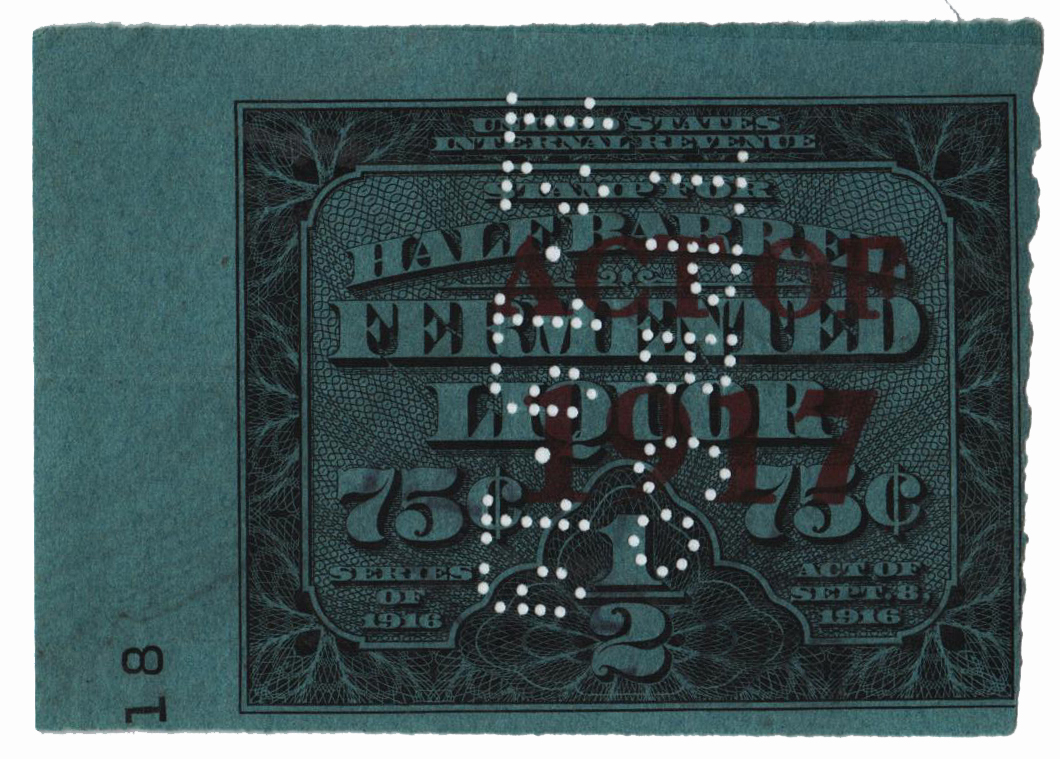
The outbreak of World War I saw the beer tax increase to $3 per barrel in 1917 and $6 per barrel in 1918. As with previous issues, existing stamps were surcharged to reflect the new tax. No beer stamps were produced or used after January 17, 1920, when prohibition went into effect.
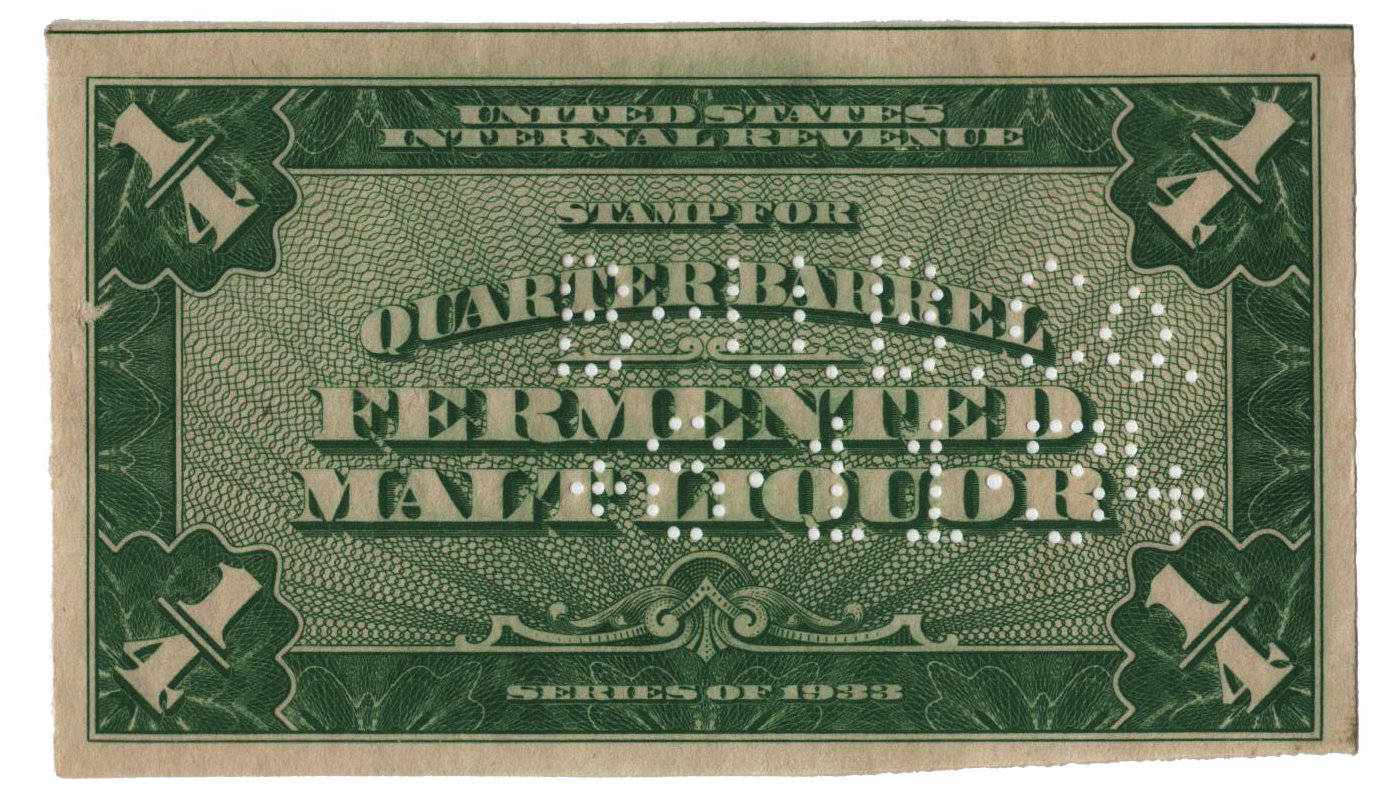
New Beer stamps wouldn’t appear until after prohibition was repealed in 1933. The stamps of this era were smaller and the word beer was replaced with “Fermented Liquor” or “Fermented Malt Liquor.” The stamps were also no longer denominated in monetary values, but simply in barrels. The tax rate over the next few years would vary from $5 in 1933 up to $9 in 1951, after which their use was discontinued.
Beer Stamps
While duties, tariffs, and state taxes on beer had been instituted decades earlier, the first large-scale federal tax on beer was created on September 1, 1862. The tax was created to help fund the Union Army for the Civil War. During those four years, officials would collect the $1 per barrel tax in cash.
When the war came to an end, the government decided to keep the tax but also decided to start producing stamps to help account for paid taxes. The tax of $1 per barrel remained the same. The new stamps were produced for various barrel sizes between 1/8th of a barrel up to 1 hogshead. A hogshead was a 63-gallon container, equal to two 31.5 gallon barrels. These first stamps were issued on September 1, 1866, making them the first stamps issued for use on alcoholic beverages, though they didn’t appear in Scott Catalogue until 1994.
Brewers received Beer Tax Revenue stamps in imperforate sheets and were required to attach the stamps to the spigot of the beer barrel before it left the brewery. In most cases, this meant the stamps were destroyed when the barrels were opened. However, some people carefully removed the stamps and preserved them.

The first two issues of Beer stamps (1866 and 1867) had ornate circular designs. The stamps of 1870 had a square format with an open rectangular area in the center for the cancellation. Each stamp had different colored security lines in the cancellation area.

Up until 1870, each set of beer stamps was produced in six different denominations. In 1871, a new series was produced featuring seven denominations. The new set included a 33 1/3¢ for 1/3 of a barrel. These new stamps had a very different design too, they pictured historical figures – Andrew Jackson, Abraham Lincoln, Daniel Webster, David Farragut, William T. Sherman, Hugh McCulloch, and Alexander Hamilton. They also featured intricate scrollwork similar to that found on paper money and other security printing.

In 1875, another new series of Beer stamps was produced. Once again it included seven denominations, but this time they all had the same central vignette, which was called “Bacchus Serving the First Fermenter Brew to Man.”

A new series in 1878 returned to featuring portraits of notable Americans, though this set featured a different group – George Washington, Thomas Corwin, Thomas Hart Benton, George Thomas, Thomas Jefferson, Andrew Johnson, and Silas Wright.

Twenty years later, the stamps of 1878 were surcharged to reflect an increase in the tax rate to $2 per barrel. The increase was put in place to help fund the Spanish-American War. Later in 1898, the stamps were reprinted with the new increased values.

In 1901, the federal beer tax was reduced to $1.60 per barrel and new stamps featuring the same portraits from the previous issue were produced. Then in 1902, the tax rate was reduced to $1, so some stamps were surcharged and then all the stamps were again reissued at the new rate.

In 1909, the design with the historical figures was abandoned and new stamps were issued with large denominations in the center. In 1914, these stamps were surcharged to a new rate of $1.50 per barrel and overprinted “Emergency Tax Under Act of 1914.” New stamps were produced later that year to reflect the new rate.

The outbreak of World War I saw the beer tax increase to $3 per barrel in 1917 and $6 per barrel in 1918. As with previous issues, existing stamps were surcharged to reflect the new tax. No beer stamps were produced or used after January 17, 1920, when prohibition went into effect.

New Beer stamps wouldn’t appear until after prohibition was repealed in 1933. The stamps of this era were smaller and the word beer was replaced with “Fermented Liquor” or “Fermented Malt Liquor.” The stamps were also no longer denominated in monetary values, but simply in barrels. The tax rate over the next few years would vary from $5 in 1933 up to $9 in 1951, after which their use was discontinued.




